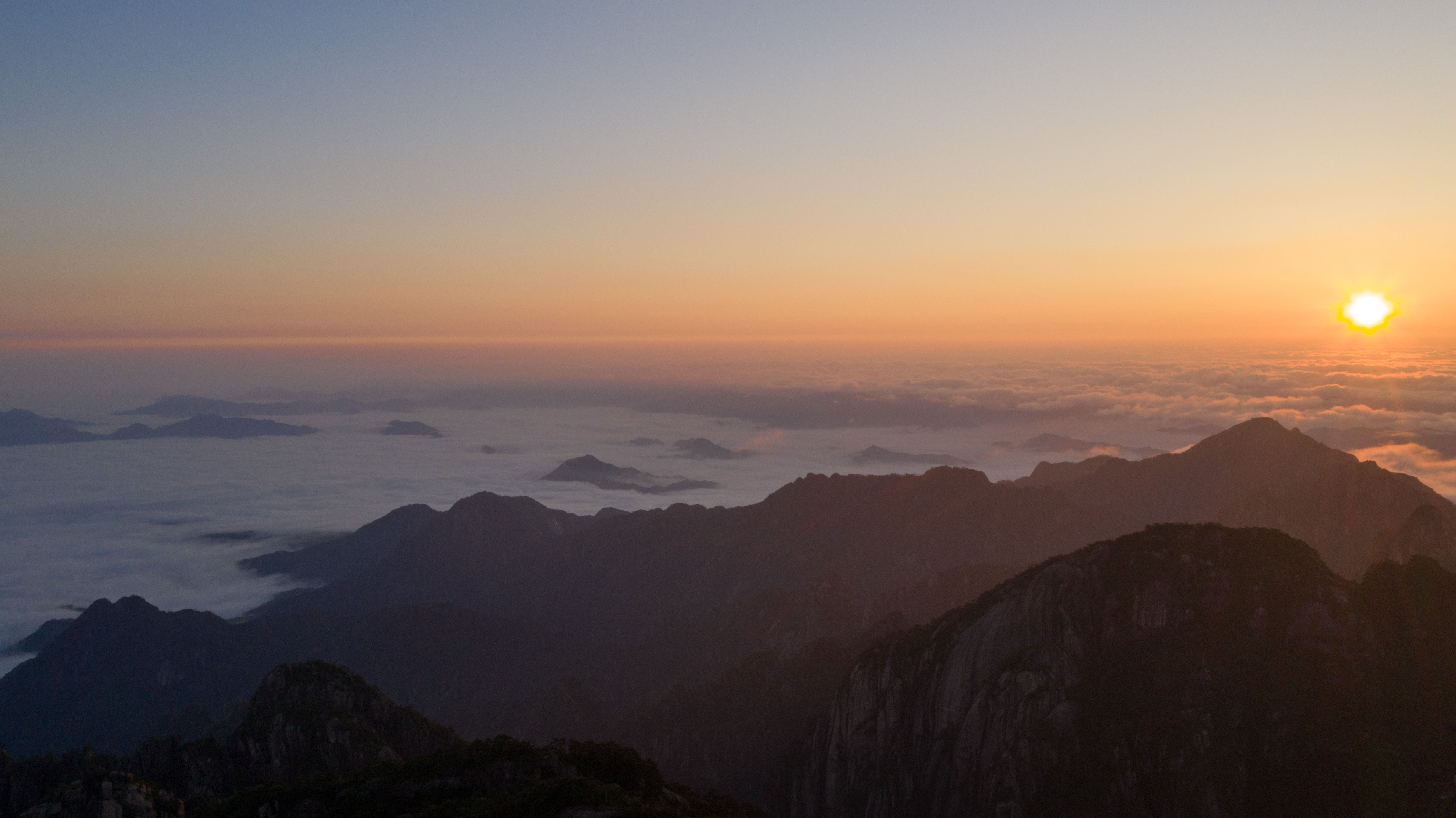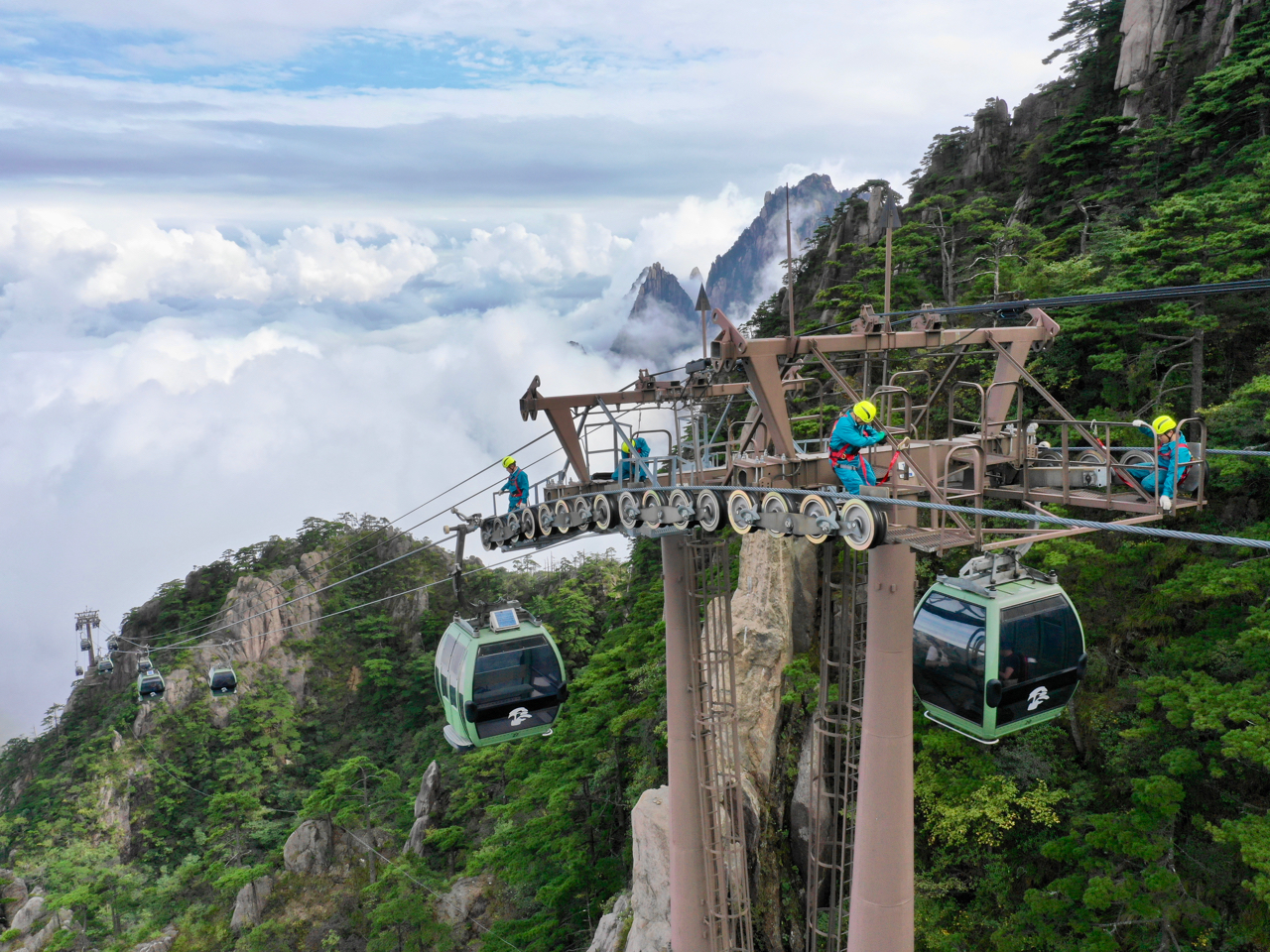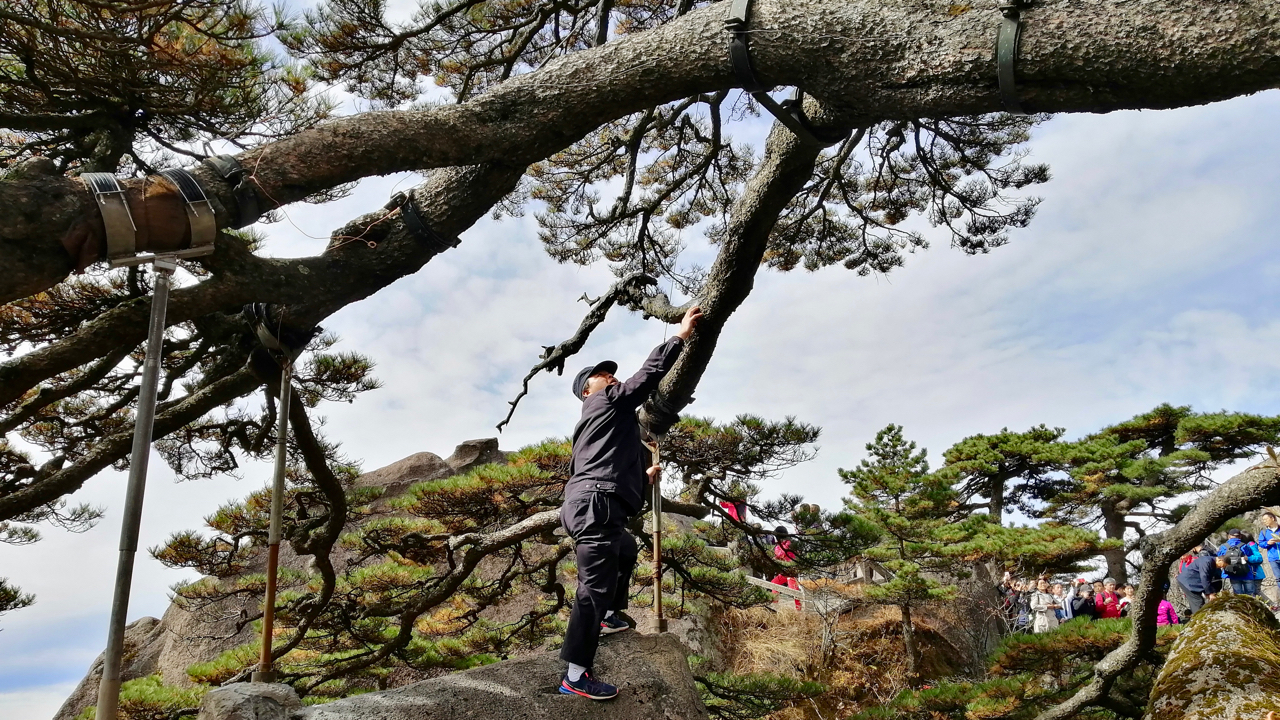HEFEI, July 16 (Xinhua) -- A train goes between rocky cliffs, up into the clouds and emerges on the other side with a view of mountain peaks shrouded by white clouds. Such video clips about Mount Huangshan as above have captivated millions on Chinese social media.
Mount Huangshan in east China's Anhui Province, with its imposing scenery and vast number of works of art and literature inspired by it, has won an entry on the UNESCO World Heritage List for cultural value and natural scenery. It, however, has another lesser known role -- the place where China's modern mass tourism took off 40 years ago.

Aerial photo taken on July 11, 2019 shows a view of Mount Huangshan at sunrise, in east China's Anhui Province. (Xinhua/Tang Yang)
In July 1979, the then Chinese leader Deng Xiaoping paid a visit to the mountain at the age of 75, where he called for all-out efforts to accelerate the nation's tourism development in a number of speeches during the visit.
Today, tourism has become one of China's important economic drivers. About 5.5 billion trips were made in China in 2018, contributing nearly 10 trillion yuan (1.45 trillion U.S. dollars) to the country's GDP, or 11 percent, according to statistics given by the Ministry of Culture and Tourism.
More than 3.3 million people visited Mount Huangshan in 2018. Forty years ago, the number was around 100,000. Over the years, the government has been improving services, infrastructure, as well as protection of the site.
ECONOMIC BOOST
In the late 1970s, China was at the beginning of its reform and opening-up. Tourism was still a new sector in the country. Many locals didn't see the tourism value of this mountain. Some even took it as a kind of obstacle since it hindered agricultural activity.
Pan Meili, manager of a local four-star hotel, was born in 1969 in a small village at the foot of Mount Huangshan, where all people used to make a living on farming.

Aerial photo taken on July 11, 2019 shows a view of Mount Huangshan and villages at its foot, in east China's Anhui Province. (Xinhua/Tang Yang)
After 1979, the villagers started to realize the economic benefits of tourism as more tourists came. Pan's parents also saw the potential of tourism and opened a family hotel.
"There were only three rooms in the family hotel which could accommodate at most 10 guests," said Pan.
Tourism gradually replaced farming in the village to be the main source of income. In the 1980s, almost everyone in the village was doing something related to tourism, such as running hotels, restaurants, souvenir shops, or working as tour guides.
"We are contributors as well as beneficiaries of tourism associated with Mount Huangshan," Pan said.
IMPROVED SERVICES
Services have been improved in the mountain for facilitating visits to the site.
"It took me 10 hours to climb to the top the first time I came to Huangshan. But we rode the cable car this time. It's much easier," said Weimar Arcila, a businessman from Colombia who is on his sixth trip to Mount Huangshan over the past decades.
Cable car service at Mount Huangshan began in 1986, which could transport people to the top in just eight minutes.

Workers perform a maintenance check of a cableway at Mount Huangshan, in east China's Anhui Province, Sept. 22, 2018. (Xinhua/Tang Yang)
Today cable car service has expanded to four cableways, including a sightseeing rail track service, to connect different parts of the mountain. The sightseeing train rose to fame after a video went viral on TikTok, a short video-sharing app, showing breathtaking views of rocks and pines in the midst of clouds when the train goes from the peak to the valley.
As more people flock to Mount Huangshan, the administration has also added options for tourists to scan a QR code and buy tickets on their cellphones.
After spending a day on the mountain, Arcila and his family decided to stay at Yupinglou Hotel for the night, at about 1,700 meters above sea level. As an old patron of the hotel, he was amazed by its recent changes.
"The hotel has been renovated. We established an art gallery displaying the history and culture of Mount Huangshan," said Pan, the hotel manager. The hotel also offers cultural activities such as tea ceremony, yoga and Taichi lessons every night at the lobby.
GREEN DEVELOPMENT
With more and more tourists, the administration for Mount Huangshan has rolled out a series of policies to strike a balance between tourism promotion and conservation, such as introducing a cap on the daily tourist number at 50,000.

Aerial photo taken on July 11, 2019 shows the Bright Summit of Mount Huangshan, in east China's Anhui Province. (Xinhua/Tang Yang)
"More tourists mean more money, but we can't be greedy. We're pursuing sustainable development," said Ge Xufang with Mount Huangshan scenic area management committee.
The administration for the mountain pioneered the practice to alternately open different tourist sites to the public in 1987. The practice was later adopted by administrative authorities of other mountain scenic spots in the country.
Lotus Peak, the highest of Mount Huangshan, was reopened to tourists this March after closing for five years, while another site Tiandu Peak was subsequently closed to tourists for maintenance.
The Mount Huangshan scenic area is also home to plenty of old and rare trees, out of which 137 are under special protection. Different measures have been adopted for protection of different trees, according to Ge.
Not far from Yupinglou Hotel stands the Greeting Pine, one of China's most well-known trees. The pine tree, growing out of the rocks with a long branch extending over the mouth of a cave, got the name mainly because it appears to be greeting anyone who arrives on the scene. It is believed to be between 800 and 1,000 years old.
To protect the pine, the local government has introduced a system of designating guardians or rangers. The first guardian was appointed in 1981. The tradition has been going on ever since.

Hu Xiaochun, the 19th guardian of the Greeting Pine, examines the tree on Mount Huangshan in east China's Anhui Province, Nov. 2, 2018. (Handout via Xinhua)
"Normally I check the tree and record details of its condition every two hours. I will nonetheless check it every 30 minutes in extreme weather when strong winds blow and heavy snow hits the mountain," said Hu Xiaochun, the pine tree's 19th guardian.
"The work can be boring if you simply view the pine as a tree, but it's a different story if you see it as a senior member of your family," said Hu. "I treat it the same way I would my own family." Enditem
(Video Reporter: Liu Fangqiang, Qu Yan, Shui Jinchen, Tang Yang; Video Editor: Zheng Xin)



